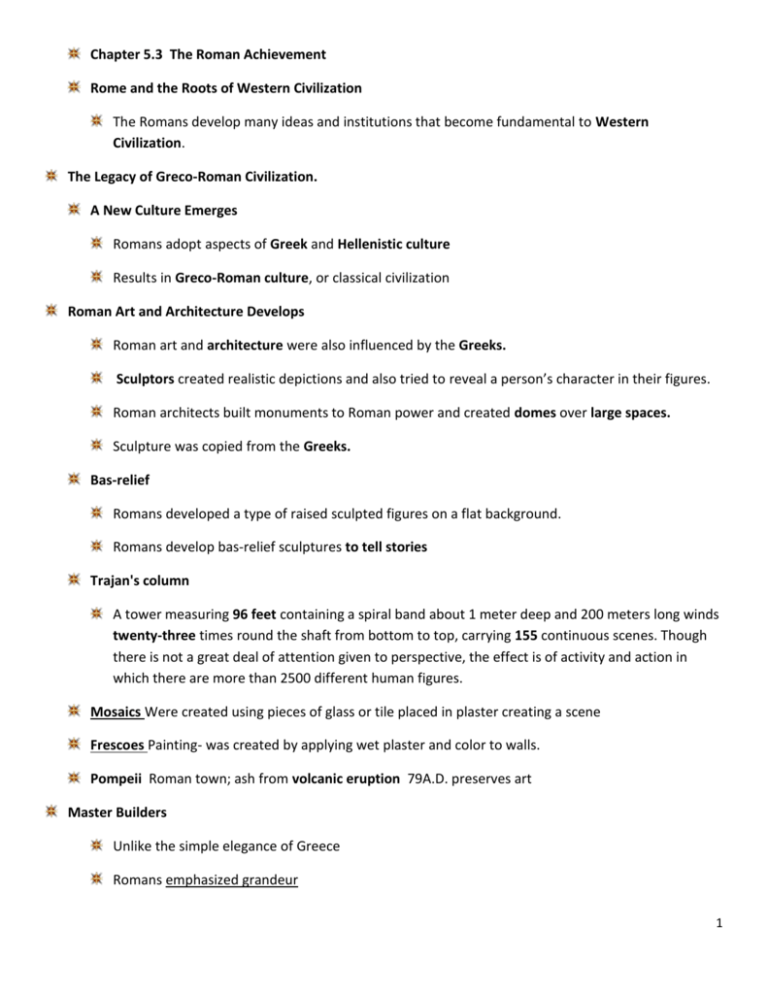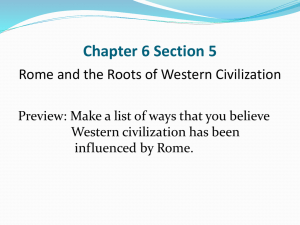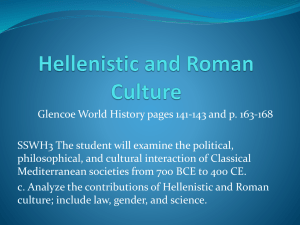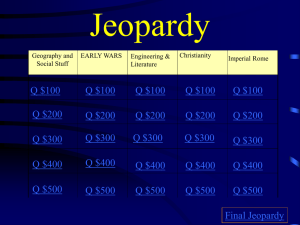WH CH 5. 3 rome achievement ppt notes
advertisement

Chapter 5.3 The Roman Achievement Rome and the Roots of Western Civilization The Romans develop many ideas and institutions that become fundamental to Western Civilization. The Legacy of Greco-Roman Civilization. A New Culture Emerges Romans adopt aspects of Greek and Hellenistic culture Results in Greco-Roman culture, or classical civilization Roman Art and Architecture Develops Roman art and architecture were also influenced by the Greeks. Sculptors created realistic depictions and also tried to reveal a person’s character in their figures. Roman architects built monuments to Roman power and created domes over large spaces. Sculpture was copied from the Greeks. Bas-relief Romans developed a type of raised sculpted figures on a flat background. Romans develop bas-relief sculptures to tell stories Trajan's column A tower measuring 96 feet containing a spiral band about 1 meter deep and 200 meters long winds twenty-three times round the shaft from bottom to top, carrying 155 continuous scenes. Though there is not a great deal of attention given to perspective, the effect is of activity and action in which there are more than 2500 different human figures. Mosaics Were created using pieces of glass or tile placed in plaster creating a scene Frescoes Painting- was created by applying wet plaster and color to walls. Pompeii Roman town; ash from volcanic eruption 79A.D. preserves art Master Builders Unlike the simple elegance of Greece Romans emphasized grandeur 1 Architects built monuments to Roman power and created domes over large spaces. Romans pioneer use of arch; also used domes and concrete Create aqueducts—structures to bring water into cities, towns Roman Forum (100 BC-300AD) was the central area around which Ancient Rome developed, in which commerce and government Senate building was started by Julius Caesar in 44 B.C. The Curia Julia was dedicated by Augustus in 29 B.C. Arch of Titus (81AD) The oldest surviving arch in Rome, it is the simplest, has only one opening, and is perhaps most well-proportioned of the arches still standing. Tabularium (78BC) The building was used as a place to store the state archives, such as deeds, laws, treaties, and decrees of the Senate. This would be where one would have seen the senatus consultum or the text of the Manilian Law. The Temple of Vespasian Built by the emperor Titus in memory of his father, Emperor Vespasian Circus Maximus (6th century B.C). Could seat 300,000 people Used primarily for horse racing, but sometimes used for mock battles Pantheon c. 125 CE The Arch of Constantine was erected between 312 and 315CE by the Senate in honor of his military triumph over Maxentius at the Battle of the Milvian Bridge. Romans Apply Science and Mathematics for Practical Use Romans were great engineers as evidenced in their roads and aqueducts. Scientific research was left to the Greeks. Romans Write Literature, History, and Philosophy Roman writers imitated Greek styles but wrote in Latin. Roman historians recorded their civilization’s highs and lows. The Hellenistic philosophy of Stoicism influenced many Roman thinkers Annals and Histories provide comprehensive look at Roman life 2 Pliny the Elder (Caius Plinius Secundus, 29-79 AD) Roman scientist Complied volumes on geography, zoology, botany and other topics based on other’s works Stoicismstressed duty, virtue, & endurance. Emperor Marcus Aurelius was a stoic and wrote Meditiations. Virgil (Publius Vergilius Maro 70-19 BC) Aeneid An epic poem written in Homeric style. The hero, Aeneus, escaped from Troy and founded Rome. Used to arouse patriotism for Augustus, just after the Civil War. Ovid- (Publius Ovidius Naso 43 BC- 17 AD) was a poet who wrote light, witty poetry for enjoyment. Juvenal (Decimus Junius Juvenalis) Wrote during the reign of the emperor Domitian (60-140 A.D.) used satire to criticize society. Martial (Marcus Valerius Martialis 40-102 AD) From the Iberian Peninsula best known for his twelve books of Epigrams published between 86- 103 AD He used fictitious names to protect himself from retribution. Tacitus-(Gaius Cornelius Tacitus 56-117AD) excels in writing factually accurate history, contained in Annals and Histories Wrote bitterly against Augustus and others who he felt destroyed Roman Liberty. Livy- (Titus Livius ?59 B.C.-17 AD), Wrote a history of Rome from its beginning to 9 B.C. Wrote of the heroics of the great heroes, Horatius and Cincinnatus The Legacy of Rome 3 The Latin Language Latin was the language of Rome and became the foundation of modern Romantic languages including: French, Spanish, Portuguese, Italian, and Romanian. More than half the words in English stem from Latin Latin was official language of Roman Catholic Church until 1960s New Law Codes Protect the Empire Civil law (applied only to Roman citizens) Laws of Nations applied to foreigners Eventually the two were merged to apply to everyone in the empire. Creating unity within the empire. Many Roman principles of law are still practiced widely today. Examples of Roman Laws 1) No person could be judged guilty of a crime until the facts were examined. 2) The accused had the right to face accusers and defend themselves before a judge 3) Where there was doubt, the accused was innocent. 4) Any law, judged to be unreasonable or unfair, could be set aside. Rome’s Enduring Influence By preserving and adding to Greek civilization, Rome strengthened the Western cultural 4








